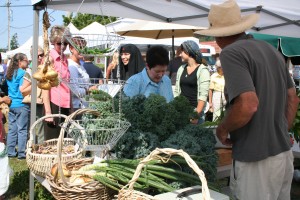We are blessed here, in our corner of the world, with a moderate climate. It never gets too cold. It never gets too hot. It rains most of the year, but that ensures us a constant flow of water even at the height of summer. In winter, we get a touch of snow which lets us do a bit of sledding and enjoy a cocoa by the fire. It never lasts terribly long, though.
This means that, with the proper planning, we can grow some crops year round. A number of farmers are already doing so here, in the state. Root vegetables do quite well underground and many greens will continue to grow if they are protected from frost. I know that baby collard green leaves, when frozen by a morning’s ice, are considered a delicacy and high-end restaurants will snap them right up.
Will Allen, an urban farming pioneer, writes in his book, Good Food Revolution, about discovering new ways to grow year-round in Milwaukee, WI, where it can be bitterly cold in winter. His favorite method is to pile his compost along the outsides of his tall hoop houses, which not only increases the temperature inside, but secures the house in strong winds. Others have composted in ditches along the insides of their hoop houses, increasing the internal warmth. Cold frames, cloches, deep mulch, haybale raised beds, and many permaculture techniques can all be used to extend the growing season right through the winter.
One of the finest sights I’ve ever seen was the fields in France covered in glass cloches in the early spring. A cloche is a blown-glass bell jar that ranges in size from a foot to 2 feet tall. Farmers place them over vulnerable seedlings. This allows them to plant earlier in the season, when there may still be frost. In our area, cloches are very expensive to buy, so why not use what we already have? When I shop at thrift stores, I constantly see large, clear-glass bowls, some for mixing, some for cooking, and some for punch. Why not use those?
There are a number of ways to inexpensively repurpose items to help you extend your season. Old windows can be made into cold frames for lettuce, scrap lumber can be found at numerous outlets in the area, including ReStore, and last year’s hay, which farmers are trying to clean out of their barns about now, works great for deep mulching. (That’s what I do with my blueberries, raspberries and marion berries. I’m telling you, I really love to pinch a penny…)
I understand that working outside in the winter has its drawbacks. The last time I repaired a fence line it was in horizontal freezing rain. I became quite familiar with a certain mind-numbing cold, as I wasn’t properly attired for such an excursion. (“Farmer-sicle” may be a good name for it.) I heavily invested in some serious rain gear and thermal wear after that.
Why is year-round production important? We don’t stop eating in the winter and good food is crucial for our health and well-being, especially when the days grow short. Year-round growing means year-round selling, which supports our farmers, who still have the same bills coming in every month. Year-round selling provides the basis for a permanent, year-round farmers market, too, which then provides a constant supply for restaurants, stores, and consumers alike. It’s a sustainable, local supply chain, is not necessarily reliant on outside products or services to thrive.


